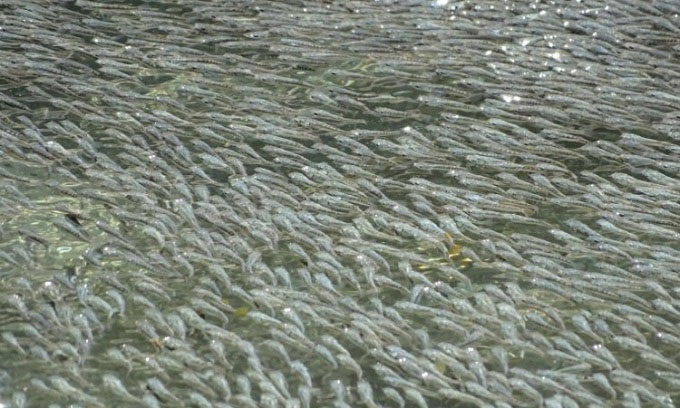Researchers have discovered that molly fish collaborate to create waves, making it difficult for predatory birds to target any individual fish.
Sulphur molly fish (Poecilia sulphuraria) are small silver fish belonging to the poeciliid family, residing in sulphur-rich ponds in Tabasco, Mexico. When disturbed, the school of fish responds by generating spreading waves. Every few seconds, thousands of fish will perform rapid diving motions to create waves, sometimes lasting up to two minutes.

School of sulphur molly fish. (Photo: Juliane Lukas)
Molly fish are preyed upon by various bird species, including herons, kingfishers, and flycatchers. When a bird dives to attack, the molly fish will thrash their tails and spin. Scientists in Germany were unable to observe the fish directly due to Covid-19. Instead, they analyzed over two years of video footage of predatory bird attacks, both in the wild and in simulations. They found that the wave-making behavior of molly fish specifically targets predatory birds perched on the shore, according to a report published on December 22 in the journal Current Biology.
According to David Bierbach, a biologist at the Leibniz Institute of Freshwater Ecology and Inland Fisheries and co-author of the study, not every bird attack triggers this behavior. For instance, kingfishers dive straight down into the water and disturb the molly fish, causing them to thrash almost all the time. However, flycatchers are much more subtle; they only dip their beaks into the water and rarely elicit a response.
The observations provided researchers with a way to test the hypothesis of whether the thrashing motion causes changes in predator behavior. They set up perches along the sulphur stream and used cameras to record flycatchers. After a bird flew over the water’s surface, researchers used a slingshot to stimulate the wave-making behavior of the molly fish, simulating a kingfisher hunting next to the flycatcher. This allowed the research team to compare the two hunting styles.
When the school of fish created a tumultuous wave, the flycatchers perched nearby. Through over 200 hunting attempts, researchers found that flycatchers waited more than twice as long before initiating a new hunting attempt compared to when the water was calm. When they attacked again, they were much less successful at catching fish than when the water was still. For kingfishers, the research team discovered that the more the fish thrashed, the longer the birds waited, as if they were waiting for the water to calm down.
This reaction reveals that the thrashing behavior not only makes it harder for predators to target an individual fish, but also that the birds are aware they will waste energy if the waves are present. This is an interesting observation because if molly fish are trying to escape from predators, their enemies could dive deeper and stay longer.
Coordinated behavior, such as swarms of locusts flashing in unison or flocks of birds moving at equal distances in the sky, has long intrigued researchers. However, it is challenging to determine the benefits of this behavior or its evolutionary reasons. Sulphur molly fish represent one of the rare cases where researchers can observe the benefits of coordinated behavior. Moving forward, Bierbach and colleagues hope to discover how the first fish dive to signal their peers and whether the diving process differs based on the type of disturbance.


















































